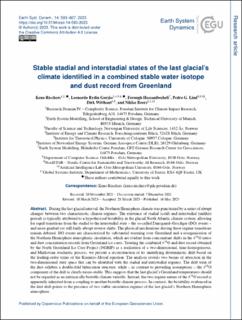| dc.contributor.author | Riechers, Keno | |
| dc.contributor.author | Gorjão, Leonardo Rydin | |
| dc.contributor.author | Hassanibesheli, Forough | |
| dc.contributor.author | Lind, Pedro | |
| dc.contributor.author | Witthaut, Dirk | |
| dc.contributor.author | Boers, Niklas | |
| dc.date.accessioned | 2023-05-30T09:24:36Z | |
| dc.date.available | 2023-05-30T09:24:36Z | |
| dc.date.created | 2023-05-16T09:04:18Z | |
| dc.date.issued | 2023 | |
| dc.identifier.citation | Earth System Dynamics. 2023, 14 (3), 593-607. | |
| dc.identifier.issn | 2190-4979 | |
| dc.identifier.uri | https://hdl.handle.net/11250/3069298 | |
| dc.description.abstract | During the last glacial interval, the Northern Hemisphere climate was punctuated by a series of abrupt changes between two characteristic climate regimes. The existence of stadial (cold) and interstadial (milder) periods is typically attributed to a hypothesised bistability in the glacial North Atlantic climate system, allowing for rapid transitions from the stadial to the interstadial state – the so-called Dansgaard–Oeschger (DO) events – and more gradual yet still fairly abrupt reverse shifts. The physical mechanisms driving these regime transitions remain debated. DO events are characterised by substantial warming over Greenland and a reorganisation of the Northern Hemisphere atmospheric circulation, which are evident from concomitant shifts in the δ18O ratios and dust concentration records from Greenland ice cores. Treating the combined δ18O and dust record obtained by the North Greenland Ice Core Project (NGRIP) as a realisation of a two-dimensional, time-homogeneous, and Markovian stochastic process, we present a reconstruction of its underlying deterministic drift based on the leading-order terms of the Kramers–Moyal equation. The analysis reveals two basins of attraction in the two-dimensional state space that can be identified with the stadial and interstadial regimes. The drift term of the dust exhibits a double-fold bifurcation structure, while – in contrast to prevailing assumptions – the δ18O component of the drift is clearly mono-stable. This suggests that the last glacial's Greenland temperatures should not be regarded as an intrinsically bistable climate variable. Instead, the two-regime nature of the δ18O record is apparently inherited from a coupling to another bistable climate process. In contrast, the bistability evidenced in the dust drift points to the presence of two stable circulation regimes of the last glacial's Northern Hemisphere atmosphere. | |
| dc.description.abstract | Stable stadial and interstadial states of the last glacial's climate identified in a combined stable water isotope and dust record from Greenland | |
| dc.language.iso | eng | |
| dc.title | Stable stadial and interstadial states of the last glacial's climate identified in a combined stable water isotope and dust record from Greenland | |
| dc.title.alternative | Stable stadial and interstadial states of the last glacial's climate identified in a combined stable water isotope and dust record from Greenland | |
| dc.type | Peer reviewed | |
| dc.type | Journal article | |
| dc.description.version | publishedVersion | |
| dc.source.pagenumber | 593-607 | |
| dc.source.volume | 14 | |
| dc.source.journal | Earth System Dynamics | |
| dc.source.issue | 3 | |
| dc.identifier.doi | 10.5194/esd-14-593-2023 | |
| dc.identifier.cristin | 2147710 | |
| dc.relation.project | EU – Horisont Europa (EC/HEU): 820970 | |
| cristin.ispublished | true | |
| cristin.fulltext | original | |
| cristin.qualitycode | 1 | |
